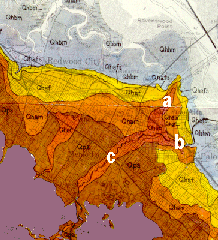
Not far from where I live is a creek called San
Francisquito by the explorer Gaspar de Portola when he camped on its banks in November of 1769.
1:sfcreek.gif:572

During the three days that Portola's party of 26
priests and 21 soldiers spent there local natives brought gifts of nuts and were generally
hospitable to their flea infested visitors.
2:ohlone.gif:573
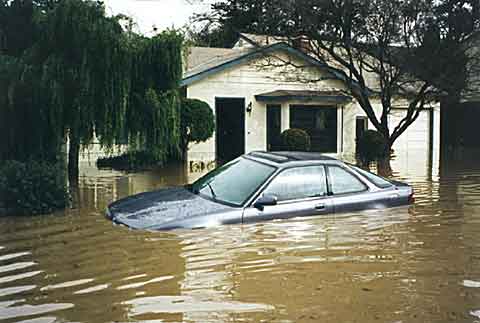
Last winter on February 3 San Francisquito Creek
produced a record flood of 7100 cubic feet per second. Creek bank erosion exposed some Native
American burials, one of a series of such finds.
3:eh001s480.jpg:574

...dating back to 1922 when a Stanford student
named Bruce Seymore found a skull duly named Stanford Man and estimated at the time by Bailey Willis
as being between 4000 and 10,000 years old. Subsequent dating of nearby grave remains in the 1960s
at 4600 radiocarbon years BP, which translates with appropriate corrections to 3200 BC on the
Julian calendar.
4:skuleye.gif:575

Note the position statigraphically of this skull,
which remains the oldest such find in the creek area, and also in Northern California. The skull
was found at the base of the Holocene alluvium about 6.1 meters or 20 feet below the top of the
creek bank.
5:skulin.gif:576
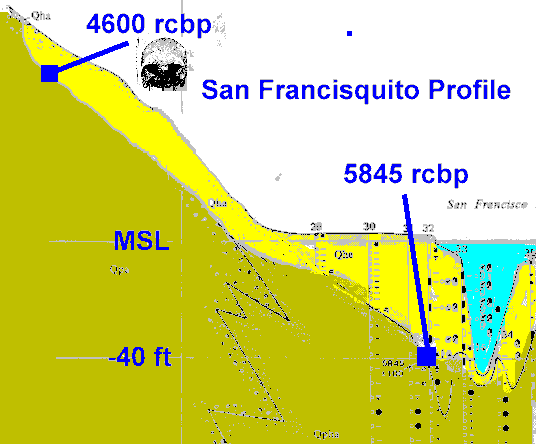
Here on this longitudinal profile of San Francisquito
Creek taken from Brian Atwater's thesis I've shown the skull, a radiocarbon date in the bay mud of
5800 years, and the characteristic delta that formed at the mouth of the creek.
6:sfcpr.gif:577

If you are a good uniformitarian and you neglect
vertical crustal movement you would infer that all rivers discharging into the sea have a similar
profile and that all such deltas began about 6000 years ago, which is exactly what a geologist named
Daniel Stanley of the Smithsonian Institute concluded based on his study of the Nile and some 30
other major rivers throughout the world.
7:trans.gif:578
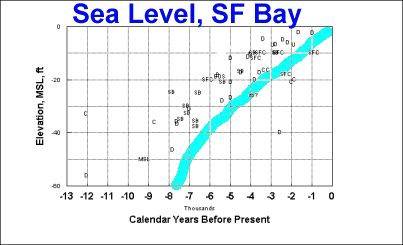
The key here of course is the stabilization of sea
level about 6000 years ago as shown on Atwater's curve for the Bay Area.
8:rlmsl1.gif:579
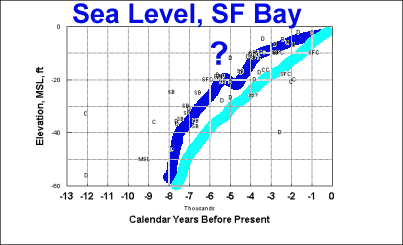
Here are Atwater's points replotted after some minor
tinkering, correcting for consolidation of bay mud. Note the area around 5000 years ago, sea level
stabilizing, still 15 feet lower than today, with a possible irregularity in the rate of rise. Keep
this irregularity at about 3000 BC in mind.
9:rlmsl.gif:580

Now we are going on an excursion to another part
of the world, lower Iraq, where the Gulf War was fought, also the area known as Mesopotamia in your
seventh grade history, with various ancient Sumerian cities, Uruk, and Lagar, Ur of the Chaldees (of
the Bible) rising out of the mud just about 5000 years ago, in other words the same 3000-3500 BC
we've been discussing in California.
10:anmes8000.gif:581
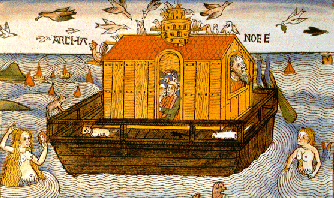
Sumerian tablets found here in 1830 showed indisputably
that the Biblical flood story was an older Sumerian story retold by the Hebrews and referring to an
event or events that occurred at 3500 BC.
11:noah.gif:582
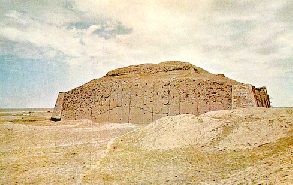
In fact in 1929 the famous English archaeologist,
Leonard Woolley, leading an expedition which included Lawrence of Arabia, Agatha Christie, and some
other colorful characters, ("Murder in Mesopotamia" came out of this) in the course of discovering
some remarkable grave treasures, excavated a deep test pit that bottomed out at sea level, about 20
feet below the floodplain.
12:pit.gif:583

aeg15. Woolley found an early layer of cultural
remains overlain by 11 feet of find sand followed by the beginnings of Mesopotamian civilization
concluding that he had found the flood.
13:sand.gif:584

The geomorphology of this area has been the subject
of several obscure papers over the years. The types of studies which could be carried out -
developed of a dated stratographic column for the mid-Holocene have naturally been impeded by the
current hostilities.
14:icoast.gif:585
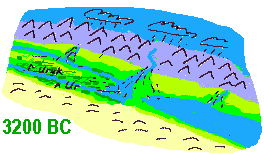
Nonetheless there seems so far little reason to
dispute Woolley's conclusion that stabilization of sea level 6000 years ago followed by blockage of
the lower valley of the Tigris-Euphrates by the larger Karun River fan flooded a very large area -
the whole world of Mesopotamia. This is much the same process that led to the formation of the
Salton Sea in 1912 (and several times before).
15:mes3201bc.gif:586

Hence we may conclude with Woolley that with
perfectly reasonable adjustment of terminology the biblical flood story (or both of them, it being
generally understood that there are two versions blended) is true, the flood waters did cover every
hill in sight of these peoples' home until the waters eroded back through whatever pulse of sediment
had blocked the lower valley near what is now the city of Basra. But what about the unusual weather
event that brought all this on?
16:mes3202bc.gif:587
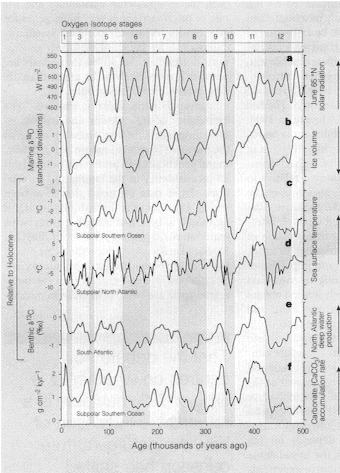
It wasn't so long ago that the hot new science of
paleoclimatology was telling us - based on ice cores indicating a remarkable stability of climate
throughout the Holocene.
17:U9.gif:588

However a closer look shows that the Holocene is
punctuated by irregularities, perhaps echoes of the extremely severe Younger Dryas event where
temperatures globally fell 20-30 degrees Fahrenheit in just a few years, as shown here in an article
published in Science just last week.
18:Image13.gif:589

The case for an abrupt climatic event at about 3200 BC
- the time of our Mesopotamian flood - emerges from several climatic indicators, some, such as the
spike of sulfate in the Greenland ice core and the rise of 300 feet in the Dead Sea, are quite
dramatic.
19:paleo.gif:590

The occurrence of the event in a sequence, which has
been respectably assigned a periodicity of 3600 years, involves major changes in atmospheric
sulfates and methane accompanied by abrupt global cooling with northerly extension of summer
monsoons.
20:holsc1.gif:591

myths..
20:holo2.gif:595

comparing with climatic signals..
21.8:holo3.gif:596

Which invites the possibility of impact from space
triggering unusual volcanism.
22:lf25.gif:592

Finally, the deceleration of sea level rise
following a possible catastrophic climatic event, the development of arable deltas worldwide which
permitted agricultural surplus, kings, land, soldiers (many fighting over exactly the same grounds
as they did six thousand years ago)
23:gulfwar.gif:593

...accountants, biblical scribes, earth experts,
prognosticators, and a tradition of storytelling which I hope I have maintained here tonight.
24:sinbad.gif:594
Questions or Comments?